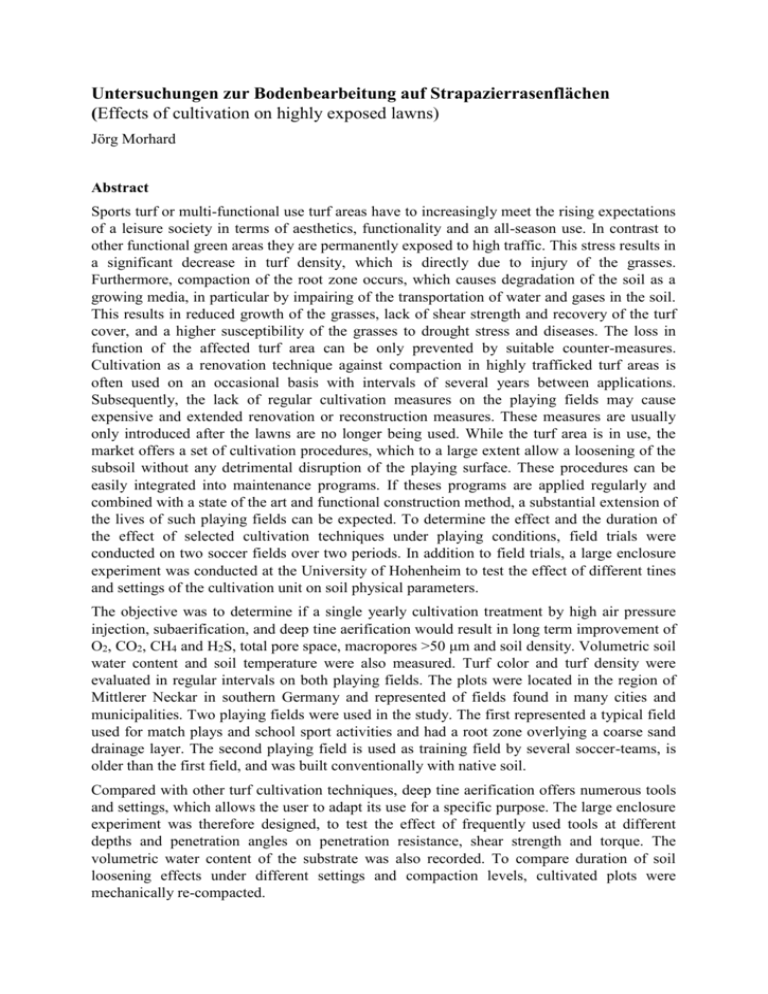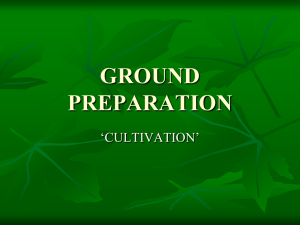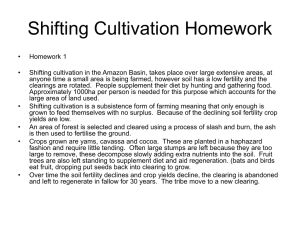Abstract
advertisement

Untersuchungen zur Bodenbearbeitung auf Strapazierrasenflächen (Effects of cultivation on highly exposed lawns) Jörg Morhard Abstract Sports turf or multi-functional use turf areas have to increasingly meet the rising expectations of a leisure society in terms of aesthetics, functionality and an all-season use. In contrast to other functional green areas they are permanently exposed to high traffic. This stress results in a significant decrease in turf density, which is directly due to injury of the grasses. Furthermore, compaction of the root zone occurs, which causes degradation of the soil as a growing media, in particular by impairing of the transportation of water and gases in the soil. This results in reduced growth of the grasses, lack of shear strength and recovery of the turf cover, and a higher susceptibility of the grasses to drought stress and diseases. The loss in function of the affected turf area can be only prevented by suitable counter-measures. Cultivation as a renovation technique against compaction in highly trafficked turf areas is often used on an occasional basis with intervals of several years between applications. Subsequently, the lack of regular cultivation measures on the playing fields may cause expensive and extended renovation or reconstruction measures. These measures are usually only introduced after the lawns are no longer being used. While the turf area is in use, the market offers a set of cultivation procedures, which to a large extent allow a loosening of the subsoil without any detrimental disruption of the playing surface. These procedures can be easily integrated into maintenance programs. If theses programs are applied regularly and combined with a state of the art and functional construction method, a substantial extension of the lives of such playing fields can be expected. To determine the effect and the duration of the effect of selected cultivation techniques under playing conditions, field trials were conducted on two soccer fields over two periods. In addition to field trials, a large enclosure experiment was conducted at the University of Hohenheim to test the effect of different tines and settings of the cultivation unit on soil physical parameters. The objective was to determine if a single yearly cultivation treatment by high air pressure injection, subaerification, and deep tine aerification would result in long term improvement of O2, CO2, CH4 and H2S, total pore space, macropores >50 μm and soil density. Volumetric soil water content and soil temperature were also measured. Turf color and turf density were evaluated in regular intervals on both playing fields. The plots were located in the region of Mittlerer Neckar in southern Germany and represented of fields found in many cities and municipalities. Two playing fields were used in the study. The first represented a typical field used for match plays and school sport activities and had a root zone overlying a coarse sand drainage layer. The second playing field is used as training field by several soccer-teams, is older than the first field, and was built conventionally with native soil. Compared with other turf cultivation techniques, deep tine aerification offers numerous tools and settings, which allows the user to adapt its use for a specific purpose. The large enclosure experiment was therefore designed, to test the effect of frequently used tools at different depths and penetration angles on penetration resistance, shear strength and torque. The volumetric water content of the substrate was also recorded. To compare duration of soil loosening effects under different settings and compaction levels, cultivated plots were mechanically re-compacted. 2 The results of the field trials show that penetration resistance of the root zone was reduced immediately after high air pressure injection, subaerification, and deep tine cultivation were applied. Significant differences between the individual techniques were found at different depths. For each of the cultivation techniques examined the period of significantly reduced soil strength, measured as penetration resistance, was found to be less than one year on both playing fields. It was limited to a period of a few weeks to six months. Treatment differences may be due to differences in soil water content at the time of application and the differences in construction in combination with different amounts of traffic. Furthermore an inverse relation between the loosening effect of deep tine aerification and soil water content was observed. As soil water content increases, the loosening effect decreased. In a first phase following the cultivation treatments a significant increase of the oxygen level in the soil air was observed. In a second phase oxygen values of the cultivated plots dropped below those of the untreated plots. This effect was the stronger, the larger the difference of the concentration of oxygen between treatment and control in the first phase was. In a third and last phase the oxygen level rose again. The same trends were observed in early spring of the subsequent year. Carbon dioxide values were high, when Oxygen levels were low and vice versa. Thus, in order to avoid the deterioration of the soil gas composition in the second phase, it is necessary to maintain the pore sizes >50 μm by additional cultivation, which also ensures adequate percolation. Elevated methane concentrations were found only in a few samples. Hydrogen sulfide was not found in the soil atmosphere of either play fields. The trials in the large enclosure experiment showed that the loosening of the soil is closely linked to the contact area between tool and soil and to the type of tine (hollow or solid tine) as well as to the length and the penetration angle of the tool. Of the different tools assessed, the highest loosening could be achieved by 12 mm solid tines (hole spacing 55 mm) at a penetration angle of 75°. This option was therefore selected in the field trials. By decreasing the penetration angle, the maximum working depth decreased only slightly for the deep tine aerification treatment. However, the root zone moved to the surface increases at the same time because of the larger heave. A larger torque is necessary to compensate for the increased heaving of the soil. At a penetration angle of 90° an increase of penetration resistance could be observed within the range of the tool tip when both solid tines and hollow tines were used. Therefore, the repeated use at the same working depth, may cause the formation of a compaction horizon. However, a penetration angle of 85° or larger did not cause any compaction at the tip of the solid tines. After re-compaction, cultivation at a penetration angle of 90° (without heave) resulted in values of penetration resistance greater than before the treatment. The greatest resistance against re-compaction was measured after 12 mm diameter solid tines (hole spacing 55 mm) were used. Based on these results, it should be possible to optimize the performance of deep tine cultivation by selecting suitable tools in combination with appropriate adjustments and by considering the drive power. In summary the results show that the cultivation techniques examined improved the soil as a growing medium for highly trafficked playing fields. For heavily trafficked turf areas a single cultivation treatment per year is not sufficient. Timing and frequency of the cultivation procedures depend on the type of treatment, the soil water content at the time of treatment, construction type of the field, and the applied traffic. Furthermore it was possible to identify several important relations which allow for the optimization of cultivation treatments as part of a maintenance program for highly trafficked turf areas. In return, these treatments can contribute considerably to an increase in quality and life expectancy of athletic fields.






